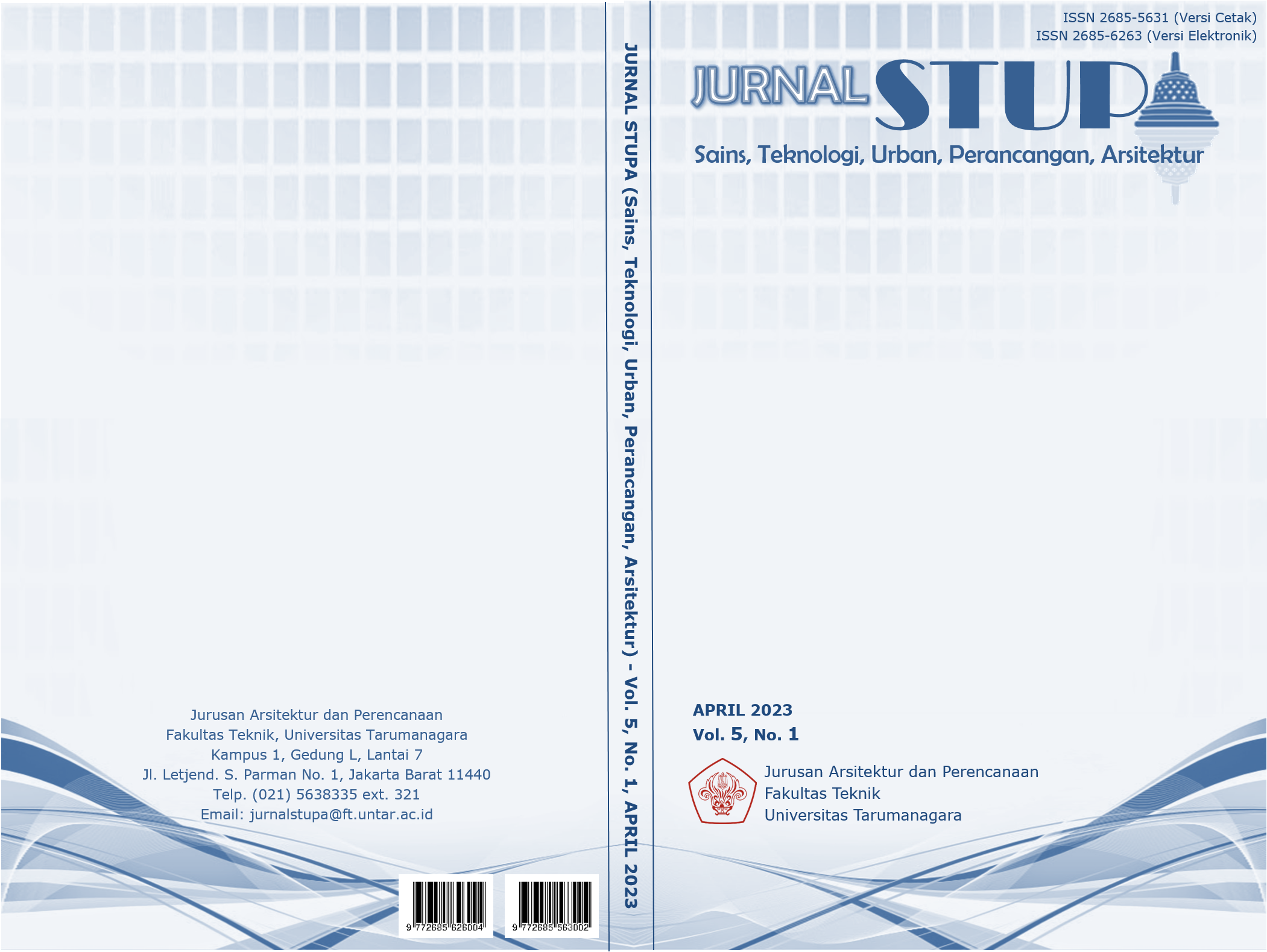MEMORI KOLEKTIF KAWASAN “LITTLE TOKYO” PADA “TEMPAT KETIGA” BLOK M
Main Article Content
Abstract
Blok M area is a part of Jakarta that is very popular with visitors and known for its endless activities. Because the Blok M area is an office and commercial area to meet daily primary and secondary needs. As a result of intense activity, the area of Blok M has undergone some degradation of the region, such as physical, social, and spiritual degradation, which has changed the image of the place. Blok M area, known as "Little Tokyo", has its own regional identity due to its strong appeal. Known as "Little Tokyo" because various Japanese people live, work and socialize with the locals around Blok M. The research method in this case is a qualitative descriptive method using pictures, maps and diagrams, supported by identifying the relationship between regional degradation and urban space and designing using the urban acupuncture method with a contextual approach. The literature review concerns the identity of Little Tokyo, the collective memory of the Block M area, and the concept of the third place. This study aims to identify and revive the local values of Blok M “Little Tokyo”, which are now disappearing. The development of this area does not destroy the existing story of “Little Tokyo”, so the concept of “Third Place” in “Little Tokyo” Blok M creates a new attraction with new efforts to open up opportunities to increase the value of the location and the investment value. In the ability to restore the collective memory of the Blok M region.
Keywords: Blok M; colletive memories; “Little Tokyo”; locality; ‘Third Place’
Abstrak
Kawasan Blok M merupakan bagian dari Jakarta yang sangat padat pengunjung dan terkenal dengan aktivitas yang tidak pernah berhenti. Karena Kawasan Blok M merupakan kawasan perkantoran dan komersial untuk memenuhi kebutuhan utama untuk kesehariannya. Akibat aktivitas yang intens, Kawasan Blok M terjadi degradasi kawasan tertentu, seperti degradasi fisik, sosial dan spiritual, yang mengubah citra tempat ini. Kawasan Blok M yang dikenal dengan sebutan "Little Tokyo" memiliki identitas kedaerahan tersendiri karena daya tariknya yang begitu kuat. Dikenal sebagai "Little Tokyo" karena banyak orang Jepang yang tinggal, bekerja, dan bersosialisasi dengan penduduk setempat di sekitar Blok M. Metode penelitian yang digunakan merupakan metode deskriptif kualitatif dengan menggunakan gambar, peta dan diagram, didukung dengan mengidentifikasi keterkaitan degradasi kawasan dengan ruang kota dan perancangan menggunakan metode urban akupunktur dengan pendekatan kontekstual. Tinjauan literatur yang mendasari penelitian ini adalah identitas “Little Tokyo”, memori kolektif Kawasan Blok M, dan konsep tempat ketiga. Tujuan dari penelitian ini adalah untuk mengidentifikasi dan menghidupkan kembali nilai-nilai lokal kawasan Blok M "Little Tokyo" yang kini mulai menghilang. Pengembangan kawasan ini tidak merusak sejarah "Little Tokyo" yang ada, sehingga konsep "Tempat Ketiga" di "Little Tokyo" Blok M menciptakan daya tarik baru dengan upaya baru untuk membuka peluang peningkatan nilai tempat dan nilai investasi yang mampu mengembalikan memori kolektif Kawasan Blok M.
Article Details

This work is licensed under a Creative Commons Attribution-NonCommercial-ShareAlike 4.0 International License.
This work is licensed under a Jurnal Sains, Teknologi, Urban, Perancangan, Arsitektur/ STUPA Creative Commons Attribution-NonCommercial-ShareAlike 4.0 International LicenseReferences
Calthorpe, P. (2011). Urbanism in the age of climate change. Washington, DC.
Casagrande, M. (2012). Urban acupuncture.
Casagrande, M. (2014). Paracity: Urban Acupuncture. Public Spaces Bratislava. Bratislava.
Colquhoun, A. (1988). Postmodernism and structuralism: A retrospective glance. Assemblage.
Creswell, J. (1994). Reserach Design Qualitative & Quantitative Approaches. California: Sage.
Danisworo, M., & Martokusumo, W. (2000). Revitalisasi kawasan kota sebuah catatan dalam . Urban and Reginal Development Institute.
Hillier, B., Penn, A., Hanson, J., Grajewski, T., & Xu, J. (2016). Natural Movement: Or, Configuration and Attraction in Urban Pedestrian Movement. Retrieved January 16, 2023, from SAGE Journals: https://doi.org/10.1068/b200029
Jenks, C. (1999). Modern movements in architecture. Revista de Arquitectura.
Lerner, J. (2014). Urban Acupuncture Celebrating Prinpicks of Change that enrich city lifes. Washington: Island Press.
Lerner, J. (2016). Urban Acupuncture. Island Press.
Mangunwijaya, Y. B. (1988). Wastu Citra. Indonesia: Gramedia Pustaka Utama.
Norberg-Schulz, C. (1979). Genius Loci: Towards a Phenomenology of Architecture. Italy: Rizzoli.
Oldenburg, R. (1989). The Great Good Place. New York: Marlowe & Company.
Shao, D., Nagai, Y., Maekawa, M., & Fei. (2018). Innovative Design Typology for Adaptive Reuse of Old Buildings in Public Spaces. Journal of Engineering Science and Technology, 3547 - 3565.
Sudikno, A. (2009, Agustus). Kearifan Lokal dalam Arsitektur Perkotaan dan Lingkungan Binaan. Seminar Nasional “Kearifan Lokal (Local Wisdom) dalam Perencanaan dan Perancangan Lingkungan Binaan. Malang: Antariksa Sudikno.
Syiariel, T. (2022). tonnysy. Retrieved January 16, 2023, from Kompas: https://www.kompasiana.com/tonnysy/622734f031794951887bc472/jelajah-little-tokyo-di-blok-m-jakarta?page=3&page_images=1.



